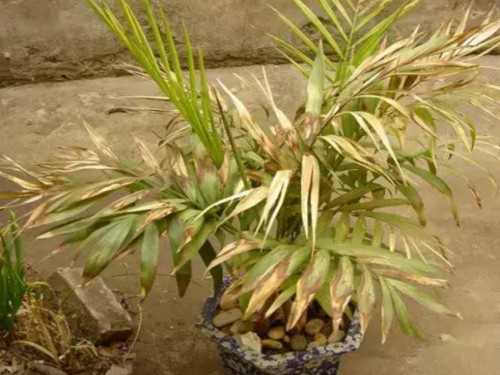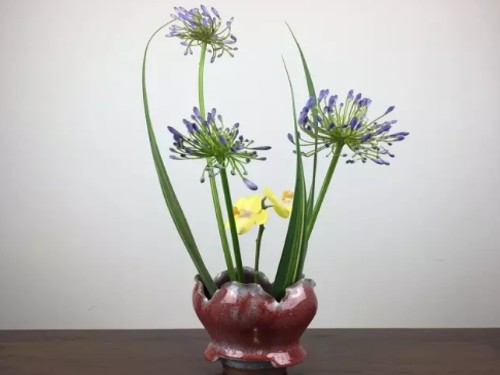The causes and Solutions of the yellowing of the leaves of Trollius paniculata
Trollius, also known as Trollius, can be cultivated perennially in southern China, while in North China it is sown in autumn and cultivated indoors in pots to make it blossom during New Year's Day and Spring Festival. The leaves are fat and beautiful, and the flowers are purple, orange, creamy yellow and so on. Golden Lotus is twining its stems and its leaves are shaped like bowl lotus. When the milky yellow flowers are in full bloom, such as butterflies, they are an important ornamental flower.

Handelia lanceolata is a beautiful flower blooming in summer and autumn. Plants always encounter some problems in the process of breeding. The most common problem is that the leaves turn yellow. What about the yellowing leaves? The following editor gives you an analysis of the causes and solutions of the yellowing of the leaves of Clematis paniculata.
The main results are as follows: 1. Overwatering: Clematis paniculata is overwatered, the drainage is not good, and the roots are prone to wet rot, and the light ones with yellow leaves fall off and the heavy ones wilt and die.
Solution: reduce watering after flowering to prevent branches from growing.
2. Long-term water shortage: the leaf tip or edge is withered and dry, and the old leaf is withered and yellow from bottom to top, but the growth of the new leaf is relatively normal.
Solution: when watering, pour enough, pour thoroughly.
3, sun exposure: flower leaf tip, leaf edge withered, dry, leaf sunrise part of the macula.
Solution: just move to the shade.
4. Lack of sunshine: if the lotus is placed in a semi-shaded or shaded place, it is appropriate for the leaves to turn yellow.
Solution: you need to be exposed to plenty of sunshine in order to grow well.
5, the temperature is too low: the cold wind blows and the hot and dry wind of heating and air conditioning blows, otherwise it is very easy to cause leaf yellowing.
Solution: it is best to keep the temperature above 10 ℃, and the lower the temperature, the more necessary to control the watering times.
6. Excessive fertilization: excessive fertilizer will cause fertilizer damage. Especially when pouring fertilizer liquid, it is necessary to prevent the fertilizer liquid from splashing on the leaves.
Solution: put it in a cool and ventilated place and stop fertilizing and watering less.
7. Long-term lack of fertilizer: the color of the young leaves becomes light, yellow or light green, while the old leaves are relatively normal or gradually change from green to yellow.
Solution: check the basin soil if there is a dry phenomenon should change the soil, usually apply thin fertilizer frequently and pour some alum at the right time.
8. Diseases and insect pests: if there is spider silk on the leaves of your lotus, or there are insects hidden in the inner page of the plant, the yellowing of the leaves must be caused by diseases and insect pests, and when it is serious, it can wither all the leaves.
Solution: increase the humidity, you can also spray mites special insecticides. At the same time, the branches threatened by diseases and insect pests should be trimmed off and cleaned up, or they can be sprayed with insecticide three times a day until the leaves turn green.
9. Season: dry golden lotus is afraid of heat, especially in summer, drought is easy to yellow leaves.
Solution: dry lotus dormancy in summer, can be put in a cool and ventilated place, stop fertilizing and less watering, Huangmei days do not let basin soil stagnant water.
Time: 2019-06-01 Click:
- Prev

What if the pocket coconut leaves turn yellow?
Pocket coconut is an evergreen small shrub, pot height generally does not exceed 1 meter, oar fruit orange, flowering in spring. Pocket coconut is a common indoor decoration plant, which is very popular with flower lovers, but the yellowing of pocket coconut leaves often occurs in the breeding process of pocket coconut.
- Next

Culture method of potted lotus in family
Baizi lotus is a mysterious and romantic flower of love, which has been blooming under the moisture of sunshine and rain, just like conveying the message of love. The hundred-seed lotus is native to the Cape of good Hope in South Africa, also known as purple orchid, blue gentleman orchid and African lily. It belongs to the genus Amaryllidaceae.
Related
- Fuxing push coffee new agricultural production and marketing class: lack of small-scale processing plants
- Jujube rice field leisure farm deep ploughing Yilan for five years to create a space for organic food and play
- Nongyu Farm-A trial of organic papaya for brave women with advanced technology
- Four points for attention in the prevention and control of diseases and insect pests of edible fungi
- How to add nutrient solution to Edible Fungi
- Is there any good way to control edible fungus mites?
- Open Inoculation Technology of Edible Fungi
- Is there any clever way to use fertilizer for edible fungus in winter?
- What agents are used to kill the pathogens of edible fungi in the mushroom shed?
- Rapid drying of Edible Fungi

